Drip Campaign – Want to launch a drip marketing campaign easily?
The visits to your website have been increasing, and people are showing interest in your brand; they have even downloaded and subscribed to your company’s newsletter! No, you are not dreaming; it’s actually happening!
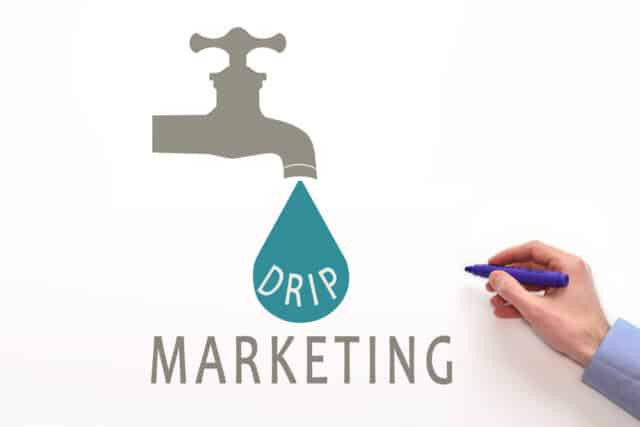
Naturally, your first instinct is to share everything positive about your company’s products and key features to gain more sales. However, before you get carried away and spam your users’ email inbox, you need to step back and behold the beauty of a drip campaign.
The right information at the right time to the right person
Drip email campaigns are an impressive and direct method of marketing for targeted customer acquisition. The process involves sending a series of carefully drafted, perfectly-timed, automated emails that are triggered by your customers’ behavior.
A drip email campaign is one of the highest converting email marketing strategies that keep track of your customers’ behavior and preferences and increase engagement. The unique feature of drip marketing campaigns is that you can anticipate and follow the user’s actions to send a targeted email drip.
The idea is to keep the content of the drips interesting, friendly, personal, and as relevant as possible. This way, you don’t crudely bombard your customers with random content. Instead, each time they visit your website, a customized drip email is sent out with the right information, at the right time, to the right people. This ultimately nurtures subscribers, and you will get more leads by doing less!
Sounds exciting, right? Let’s investigate the core concept of an email drip campaign and observe its many benefits!
Curious about the drip in email marketing? Let’s find out
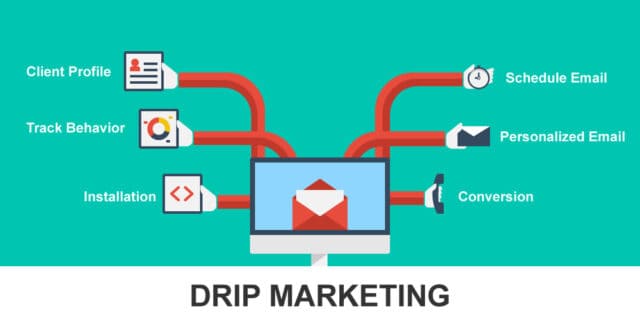
You must be familiar with the popular agricultural technique of drip irrigation in which small amounts of water are dripped over plants at regular intervals. Just like the drips in drip irrigation deliver the right amount at the right time, the slow, steady, and relevant drip campaign emails save you the energy and time from rigorous campaigning.
A targeted drip email campaign can help you to create trust with your customers and gain new subscribers. Furthermore, sending customized and exact content nudges potential customers to make a decision.
Many names, one concept
Before we go in-depth about a drip marketing campaign, you should know that drip marketing is a blanket term for an email drip campaign. Commonly referred to as drip campaign emails, it has several other names like email marketing, automated email campaigns, lifecycle emails, autoresponders, marketing automation, automated drip campaigns, and finally, drip marketing. The concept is, however, the same—a set of email drip campaign emails that are sent out automatically on specific dates and times to gain a loyal customer base.
Furthermore, a drip-email campaign also includes marketing through direct emails and phone calls. However, an email drip campaign is the most cost-effective, efficient, and easier way to gain leads in the sales funnel, so let’s focus on the uniqueness of drip campaigns and the several benefits of email marketing they offer to your business.
Let’s learn from some of the best email drip campaign examples
Example 1
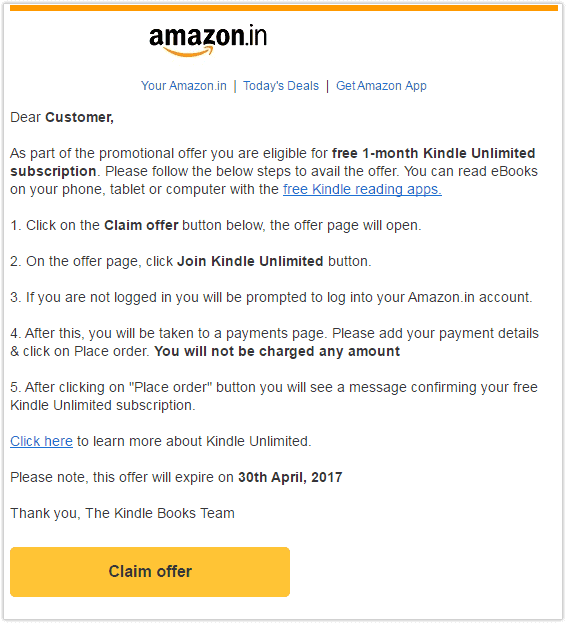
You are looking at an email drip campaign for an upsell offer by Amazon. Let’s consider why this is a good example—
- It is relevant. The drip is sent to a user who has probably downloaded all the free stuff from Amazon Kindle. Sensing the user’s interest, Amazon sent a drip to nudge the user to try out Kindle Unlimited for a month.
- It is goal-oriented as it propels the user to sign up for an annual subscription to Amazon Kindle Unlimited.
- It is urgent as it highlights a deadline for the offer. The expiry date for the offer is 30th April 2017, thus insinuating urgency and nudging the user to make up their mind quickly.
- It is precise and clearly explains the process in a step-by-step manner, prompting users to sign up immediately.
Example 2
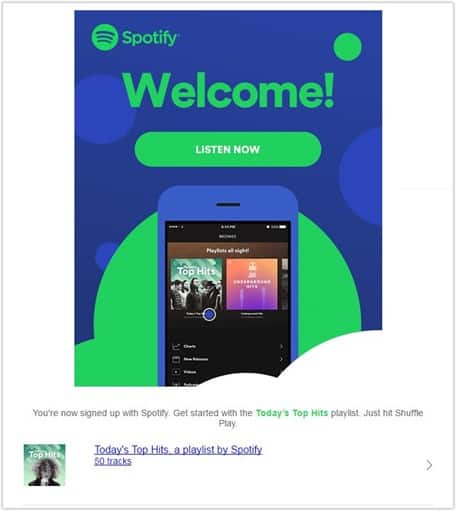
You are looking at a simple welcome email by Spotify. Businesses use welcome drips that include onboarding emails or a single welcome email. Onboarding emails generally include a series of drip emails that informs the user about their products and services or highlight the prospects for a future purchase.
Example 3

You are looking at an up-gradation drip by Grammarly. Usually, when you sign up for a free trial of a product, closer to the end of your trial period, you receive automated messages from the provider asking you to upgrade your trial to a premium version. As such, up-gradation drips are often effective and are widely used by businesses to boost online sales.
Example 4
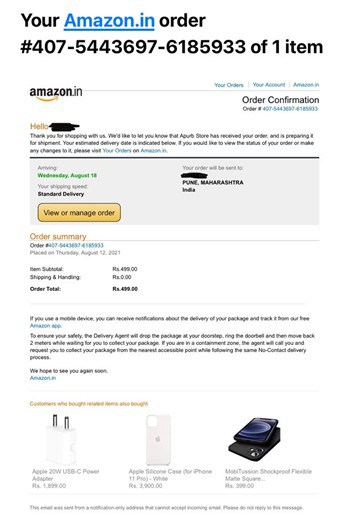
You are looking at Amazon’s order confirmation drip. Along with the order summary, businesses usually also include related items that are often bought together. As such, drip campaigns are a great way to boost sales. Based on the user’s current purchase, the drip email subtly suggests related items and nudges further purchase.
Example 5
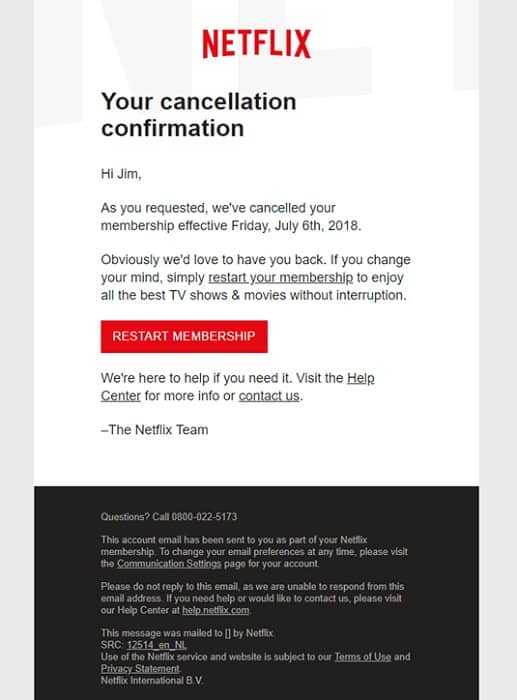
You are looking at Netflix’s Win-Back campaign drip. Most businesses use a similar template when their loyal customers leave. To woo them back, businesses use re-engagement tactics, one of which is the win-back drip campaign, sometimes also through free trials. In this example, to combat the loss of a subscription, Netflix has smartly created a win-back drip campaign with a targeted message, emotional trigger, and precise contact address. This is their best shot to reduce churn rate and boost engagement.
Is there a certain number of emails that should be sent in a drip campaign?
This is a common question—how many drip emails to include in a campaign? Well, there is no direct answer. However, you may consider the following parameters—
- What are you selling or promoting?
- How engaged is your client base?
- How is your product lifecycle?
For instance, if it is a drip campaign for an abandoned shopping cart, you draft the email once and then personalize and automate the sending.
Another option is to send emails based on your visitor’s triggers or actions. If someone signs up for your service, for example, you can send a welcome email initially, then a second drip on your most popular content after 2 or 3 days.
However, in the end, you need to test the waters. Usually, three drip emails are good to start with. You can, however, have two or five also. If the third drip email doesn’t bring you the anticipated reaction from your subscribers, or if there are far too many unsubscribes, you can modify your campaign to 2 drip emails.
On the other hand, if several customers are converting from the third drip email, you may also add a fourth or fifth scoop.
Your goal is to keep your brand at the top and, at the same time, not over-communicate. Remember, too many drip emails will annoy and drive away your customers. Finally, you and your sales team are the best judges to decide on the right number of drip emails for your campaign that will add value to both you and your clients.
It’s all in the timing—Let’s understand when to use a drip campaign for your business
Some of you may tend to believe that email drip campaigns are old-school, as the concept has been around as long as the existence of emails. So, it is obvious to be curious about its benefits and its works. To avail positive results from the drip campaign, you need to nail the timing. It’s all about sending your audience the right information when they need it.
In the above section, we already saw a few examples of when businesses use drip campaigns; however, here are a couple more common case examples where you can set up automated drips to provide targeted information to niche users and nudge them into becoming full-time customers—
To nurture leads
Leads are important to onboard people who you see as your potential customers and who would buy your products in the future. In such a case, you design your drip campaign to educate this segment of the potential client base. Your drips will inform them about your service and features.
Some businesses also leave room for free trial users—the goal is to do a bit of hand-holding and nurturing until you have them onboard for purchase. As such, drip emails will help you enormously to nurture leads and to turn a potential customer into a paying customer.
To welcome
With your excellent marketing strategies, you have been able to attract a substantial amount of people who have signed up for a trial. But, what next? After the signing-up, you can strategize your drip campaign in helping your new users to learn more about your products & services. You could wish to emphasize your Unique Selling Point—what distinguishes you apart—at this point.
At this stage, welcome emails will do the trick for you. Welcome drips provide concise and immediate information to your company’s top content. They also act as a primer and nudge people to use your product.
Furthermore, you can also use the welcome drip for your newsletter subscribers.
To onboard
Onboarding drips are a great way to propel users to eventually sign up or purchase your products. Onboarding emails should include targeted and customized “sells” or goals that will ultimately compel users to pay for your product. Your messages may include a straightforward CTA—’ download our mobile app, sign up for our newsletter, or even purchase a premium subscription.’
To notify about abandoned shopping carts
We are sure you also have, at some point in time, generously clicked on the ‘add to cart button, loaded a shopping cart to the brim, and then completely ditched it before making the final payment. One of the most prevalent purchasing scenarios is this.
However, you can retrieve the lost sale from abandoned shopping carts with an automated drip campaign. For this, you need to re-engage the customers to the unpurchased products in their cart through customized drips and subtly lead them to buy.
You may also send a follow-up drip and confirm that the products they wished to buy are still available.
To recommend
“If you like Downtown Abbey, you might also like….” This notification isn’t just common for Netflix—recommendation drips are used by almost every giant online retailer. Umm…we are not hinting at Amazon; you are!
The key is the more a company knows about your interests and buying habits, the better they can anticipate what you might or might not like. It is basically this information about your purchasing tendency that helps businesses to send you targeted recommendation drips about products.
Let’s suppose a new buyer purchases a water purifier from you. In the order confirmation mail, you may suggest a zip-cover for the purifier that is often bought by other shoppers. Furthermore, after a few months, you can send a second drip mail suggesting the purchase of replacement filters.
Even entertainment apps like Spotify and Netflix send you targeted drips based on the music and web series you choose.
To renew
Renewal drips are common after a customer has extended her subscription or when the subscription is about to run out. However, by leveraging your renewal drip, you can nudge your customers to a renewal process.
You may also use an autoresponder that sends an alert when the account needs to be recharged. Finally, for customers who do renew, make sure to send them a thank-you drip for staying loyal to your service. Further, you can also send a drip to share your product and their experience with their friends.
To confirm
You have closed a new sale and are congratulating yourself for a good deal. However, don’t pat your back just yet; you can even use a confirmation drip that may include links to the product’s newest features. This will strengthen the customer’s engagement with your brand.
After every purchase, it is obvious to send an email receipt, but confirmation drips leverage the communication with related products, services, and upsells. Offering a coupon for any purchase in the future guarantees returning customers.
In a situation of repeated unsubscribes
Let’s hope you never have to resort to this option. However, if a user unsubscribes your e-newsletter, you may use drip emails to follow up. The contents may include a request for feedback. Furthermore, you can also send a drip that offers an incentive, thus encouraging them to subscribe or woo them back.
You may also follow up again after 3 or 6 months.
The benefits—Why should you use a drip campaign for your business?
Drip campaigns are most beneficial to start-ups, small companies, and novice marketers, mainly because email drips are easy to set up require fewer analytics and less resource investment in general. If your goal is to earn immediate sales, drip campaigns have to be your go-to option.
Furthermore, drip campaigns offer long-term goals through successfully nurtured relationships with leads-turned-paid customers. With a drip campaign, you can also monitor the website visitor behavior of your leads. You will be able to provide tailored services as a result of this.
In a nutshell, you should consider launching a drip campaign for your business for the following reasons—
- To increase awareness of your brand.
- To gather customer data and feedback.
- To promote new products.
- To build engagement and community.
- To personalize user experience that guarantees higher engagement and conversion rates.
- To onboard users for upcoming events.
DIY drip campaign for your business
Now that we have covered the basic idea of a drip campaign let’s get started on how to use it to the fullest for your business in order to avail of maximum marketing, selling, and nurturing benefits.
To make it less daunting, let’s break down the set-up process of a drip campaign into five crucial steps:
Step 1: Determine your trigger
Triggers are the first thing you will need to contemplate before setting up a drip campaign. They set your campaign in motion and help to create an actionable workflow. Triggers either cause new leads or drive them further down the funnel.
Depending upon your business type, the range and number of triggers will vary. Two types of triggers help to create drip emails, viz. user’s actions on your app or your website, and user’s demographic information.
Some of the most common examples of drip campaign triggers are:
- A new user subscribes to your newsletter; sending her a welcome email is part of your drip campaign.
- A new user makes a purchase; sending him a receipt with shipping information will be part of your drip campaign strategy.
- Its been a week since a user signed up for your service, but she has not visited your site after that; you send her an automated email.
- A user started to create a user’s profile with your app but stopped halfway and left it incomplete; sending a drip email with tips will be an integral part of your drip email strategy.
So, choose the right action and date to base your campaign upon. Then layout your triggers so that every drip email is directly related to a trigger. This way, users will also know why they’re getting your email.
Step 2: Identify your audience
The unique feature of drip campaigns is that they allow you to send targeted information to niche clients. Therefore, while setting up your campaign, it is important to determine triggers as well as the audience you have chosen for your drip campaign.
You can fix your targeted audience segment by judging specific user behavior, after which you can build a profile for every individual user. Remember, for an effective drip campaign to be effective, you need to target specific user behavior.
You can determine your potential client segment based on user characteristics like—
- Visit and shopping frequency: How often do they visit your site? Weekly or monthly? How often do they shop?
- Click rates: Which content in a newsletter interests them? When did they sign up? How often would they go to your website’s premium page? Are they paying customers? It’s been how long?
Know that the recipients of your drip campaign are usually those users who have already shown interest in your brand and who already subscribe to your email. This niche segment of recipients makes the drip emails more effective. This segment of the targeted audience further also helps you to serve their needs in a better way.
Step 3: Craft targeted messages for every email
Now that you have ironed out the first two steps, the next thing to do is to create carefully crafted messages to engage your audience. Remember, your email content and how you present it will impact your leads. You may want to consider the following tips while drafting your email:
- Design your drip to deliver a call-to-action message that will nudge the user to act.
- Draft personalized emails. Adding a personal touch ensures user engagement, as impersonal and random emails are often ignored.
- Let the email be short, clear, and consistent with your brand and targeted products. Adding a catchy subject line will boost open rates.
- Consider relevance. Ask yourself the question—what can be the most relevant content to this action of the customer? Remember, your content should address the customers’ immediate needs.
- Finally, ask yourself—what do you want the users to do? Or, what would you like them to take away from the drip email?
Step 4: Measure your campaign
This step will test your judgment and instinct. At this stage, you will have to figure out critical questions such as— How many emails should I send? In what order? When? How am I going to measure my results?
The answers lie in the way you map out your campaign. You may want to consider the following tips before you launch—
- The content of your drip
- The audience it reaches
- The time it reaches them
- The overall goal of your campaign strategy.
To measure the result, monitor the response to your emails, the click rates, user actions, and conversion rates. Furthermore, don’t hesitate to adjust your campaign based on user performance. You may also test different imagery. Use trial and error until you have figured out the right formula.
Step 5: Run and Open
Congratulations, you may finally breathe! You have reached the final step. At this stage, you just need to hit the ‘send’ button. Here you need to create custom and targeted drip software.
Remember to maintain your drips and review them periodically, just to make sure your content doesn’t go stale and become irrelevant.
How do you pick the best drip email software for your company?
To create a powerful drip campaign strategy, use marketing automation. You’ll be spoilt for choice with the many state-of-the-art tools available in the market as every platform has its own set of unique features and pricing options.
However, which one to zero in on? Fret not; we are here to help you choose the drip campaign tool that’s perfect for your needs. To make the right choice, you may want to consider the following features:
Automation
Pay attention to the range of automation features the tool offers. Look for pre-built processes like welcome series, discarded cart, and post-purchase, among others.
Easy workflow set-up
The best automation platforms usually offer an easy-to-use drag-and-drop workflow build. With just a few mouse clicks, you may establish a new workflow.
Segments and customized messages
Automation tools with advanced segmentation help you to personalize your drip campaigns. Furthermore, advanced segments will help you to target specific audiences and to create hyper-personalized content.
Email templates
To save your time, look for automation tools that offer a varied choice of templates for specific email drip campaigns. It is easy to customize such templates with your own content.
Affordability
Well, this doesn’t need reminding, but you don’t want to rob a bank for an automation tool. So, look for apps that have a reasonable starting price. Most of the apps charge based on the number of subscribers. Make the best use of your research. Evaluate if your app choice will profit you financially if you increase your number of subscribers in the future.
Choose from some of the most popular app choices
AWeber
This app is mostly wanted for its free option.

Flodesk
This is particularly in demand for its large lists and simple drip campaigns.

ConvertKit
This tool is especially popular among solopreneurs.

ActiveCampaign
This app is favored for its live chat and advanced drip automation.
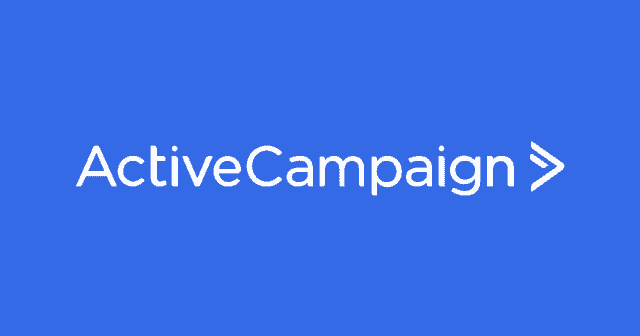
HubSpot
Experts believe this app is especially liked for its personalized follow-ups to drip sales campaigns.
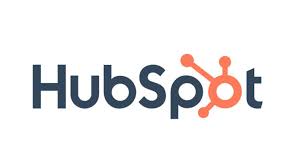
Kajabi
Finally, in our list, this app is most sought-after for its all-in-one solution for its course and membership creators.

How to Measure Drip Marketing Results?
From the above article, you must have fairly understood the importance of metrics to measure the success of your drip campaign. However, it is obvious to wonder about the best way to track the number of users and measure their reaction to your content.
A lot of businesses use UTM codes or URL parameters. UTM is short for “Urchin Traffic Monitor.” These are short text strings that go at the later part of a Link. They have no bearing on the final destination.
These codes are used by Google Analytics that inform you about the user, its location, their visit frequency, and other such metrics. With Google’s custom URL builder, you can even create UTM codes.
A question mark precedes the UTM code. For instance, below, the UTM code is what comes after the question mark:
https://www.example.com/blog/app-audit?utm_source=dripintro
In closing, we would like to remind you that drip campaigns are known to generate 2-3 times higher performance and conversion rates than bulk emails. Furthermore, if you combine more marketing channels, you could further boost your leads.
If you are a start-up, you may want to first launch the ‘welcome, cart abandonment, customer reactivation drip emails’ as these are highly effective, in addition to being easy to implement.
You might also want to remember that small details will impact your campaign. For instance, if you notify a potential customer about free shipping on the product she has recently shown interest in, it might help you to seal the deal.
Lastly, remember in the age of social media and other top-notch marketing strategies, email is here to stay and is still regarded as one of the most effective marketing tools! So, by launching drip campaigns for your business, you are not only leveraging the power of email but also providing a personalized experience for your customers.
It’s time to get, set, drip!
Subscribe to our Newsletter
Sign up to receive email updates on new product announcements, exclusive sales and marketing content, special offers on email validation plans, and more.
We send curated content as per your preference and do not indulge in spam!
What would you like to know about
We’re committed to your privacy. TuxMailer uses the information you provide to us to contact you about our relevant content, products, and services. You may unsubscribe from these communications at any time. For more information, check out our privacy policy.
